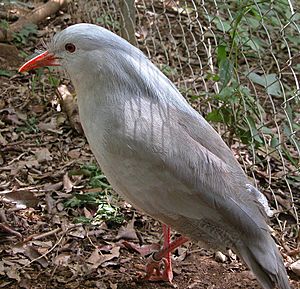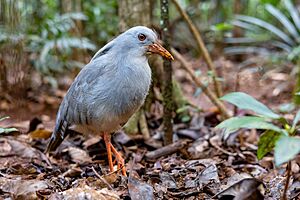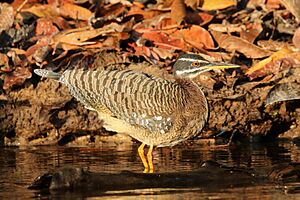Eurypygiformes facts for kids
Quick facts for kids Eurypygiformes |
|
|---|---|
 |
|
 |
|
| Scientific classification |
|
| Kingdom: | Animalia |
| Phylum: | Chordata |
| Class: | Aves |
| Clade: | Eurypygimorphae |
| Order: | Eurypygiformes Hackett et al., 2008 |
| Families | |
|
|
Eurypygiformes is a special group of birds. It includes the kagus, which are found only in New Caledonia. It also includes the sunbittern, which lives in tropical parts of the Americas. These birds are quite unique. Their closest relatives seem to be the tropicbirds, which live in warm ocean areas around the world.
Contents
Understanding Eurypygiformes Birds
This bird group is made up of two families. They are ancient birds from a supercontinent called Gondwana. Scientists have studied their features to understand where they fit in the bird family tree.
Where They Fit In
At first, scientists thought these birds were related to herons. Later, they were grouped with cranes and similar birds. But new studies, especially those looking at their genes, show they are related to tropicbirds. The oldest known fossil of a bird from this group is a type of sunbittern. It was found in the United States and is about 50 million years old.
The Kagu and Sunbittern Connection
The kagu and the sunbittern are very close relatives. They are like sister species. Scientists believe their common ancestor lived a long time ago. This ancestor was separated when the supercontinent Gondwana broke apart. One group ended up in South America, and the other in New Caledonia.
Both the kagu and the sunbittern have special "powder down" feathers. These feathers break down into a fine powder. This powder helps them clean and waterproof their other feathers.
The Extinct Lowland Kagu
The kagu you see today is the only living species in its family. But there was once a larger relative called the lowland kagu. This bird lived in New Caledonia too. It was about 15% bigger than the kagu we know.
The lowland kagu became extinct after humans arrived in New Caledonia. Many other species also disappeared around that time. Scientists think the lowland kagu lived in the lowlands, while the modern kagu lived in the highlands.
Meet the Eurypygiformes Species
Here's a look at the two main species in this bird group. You can see their populations and how they are doing today.
| Common Name | Scientific Name | Population | Status | Trend | Notes | Image |
|---|---|---|---|---|---|---|
| Kagu | Rhynochetos jubatus | 601–2,000 | Endangered | This means there are only about 250 to 999 adult birds left. |  |
|
| Sunbittern | Eurypyga helias | 500,000–4,999,999 | Least Concern | This is an estimate for adult birds only. |  |

